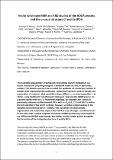Files in this item
In situ solid-state NMR and XRD studies of the ADOR process and the unusual structure of zeolite IPC-6
Item metadata
| dc.contributor.author | Morris, Samuel A. | |
| dc.contributor.author | Bignami, Giulia P. M. | |
| dc.contributor.author | Tian, Yuyang | |
| dc.contributor.author | Navarro-Rojas, Marta | |
| dc.contributor.author | Firth, Daniel S. | |
| dc.contributor.author | Cejka, Jiri | |
| dc.contributor.author | Wheatley, Paul S. | |
| dc.contributor.author | Dawson, Daniel M. | |
| dc.contributor.author | Slawinski, Wojciech A. | |
| dc.contributor.author | Wragg, David S. | |
| dc.contributor.author | Morris, Russell E. | |
| dc.contributor.author | Ashbrook, Sharon E. | |
| dc.date.accessioned | 2017-10-17T23:33:28Z | |
| dc.date.available | 2017-10-17T23:33:28Z | |
| dc.date.issued | 2017-10 | |
| dc.identifier | 249163796 | |
| dc.identifier | 53f7b71e-b431-4707-b363-464539b46ded | |
| dc.identifier | 85029768034 | |
| dc.identifier | 000411474800016 | |
| dc.identifier.citation | Morris , S A , Bignami , G P M , Tian , Y , Navarro-Rojas , M , Firth , D S , Cejka , J , Wheatley , P S , Dawson , D M , Slawinski , W A , Wragg , D S , Morris , R E & Ashbrook , S E 2017 , ' In situ solid-state NMR and XRD studies of the ADOR process and the unusual structure of zeolite IPC-6 ' , Nature Chemistry , vol. 9 , no. 10 , pp. 1012-1018 . https://doi.org/10.1038/nchem.2761 | en |
| dc.identifier.issn | 1755-4330 | |
| dc.identifier.other | ORCID: /0000-0002-4538-6782/work/56638925 | |
| dc.identifier.other | ORCID: /0000-0002-8110-4535/work/34029105 | |
| dc.identifier.other | ORCID: /0000-0001-7809-0315/work/61622085 | |
| dc.identifier.uri | https://hdl.handle.net/10023/11876 | |
| dc.description | R.E.M. and M.N. thank the Royal Society and the E.P.S.R.C. (Grants EP/L014475/1, EP/K025112/1 and EP/K005499/1) for funding work in this area. R.E.M. and J.Č. acknowledge the Czech Science Foundation for the project P106/12/G015 and OP VVV "Excellent Research Teams", project No. CZ.02.1.01/0.0/0.0/15_003/0000417 - CUCAM. S.E.A. would like to thank the ERC (EU FP7 Consolidator Grant 614290 “EXONMR”) and the Royal Society and Wolfson Foundation for a merit award. The UK 850 MHz solid-state NMR Facility used in this research was funded by EPSRC and BBSRC (contract reference PR140003), as well as the University of Warwick including via part funding through Birmingham Science City Advanced Materials Projects 1 and 2 supported by Advantage West Midlands (AWM) and the European Regional Development Fund (ERDF). W.A.S. and D.S.W. acknowledge the Research Council of Norway and NOTUR are acknowledged for providing the computer time at the Norwegian supercomputer facilities (under the project number NN2875k). | en |
| dc.description.abstract | The assembly–disassembly–organization–reassembly (ADOR) mechanism is a recent method for preparing inorganic framework materials and, in particular, zeolites. This flexible approach has enabled the synthesis of isoreticular families of zeolites with unprecedented continuous control over porosity, and the design and preparation of materials that would have been difficult—or even impossible—to obtain using traditional hydrothermal techniques. Applying the ADOR process to a parent zeolite with the UTL framework topology, for example, has led to six previously unknown zeolites (named IPC-n, where n = 2, 4, 6, 7, 9 and 10). To realize the full potential of the ADOR method, however, a further understanding of the complex mechanism at play is needed. Here, we probe the disassembly, organization and reassembly steps of the ADOR process through a combination of in situ solid-state NMR spectroscopy and powder X-ray diffraction experiments. We further use the insight gained to explain the formation of the unusual structure of zeolite IPC-6. | |
| dc.format.extent | 7 | |
| dc.format.extent | 6363332 | |
| dc.language.iso | eng | |
| dc.relation.ispartof | Nature Chemistry | en |
| dc.subject | QD Chemistry | en |
| dc.subject | DAS | en |
| dc.subject | BDC | en |
| dc.subject | R2C | en |
| dc.subject.lcc | QD | en |
| dc.title | In situ solid-state NMR and XRD studies of the ADOR process and the unusual structure of zeolite IPC-6 | en |
| dc.type | Journal article | en |
| dc.contributor.sponsor | EPSRC | en |
| dc.contributor.sponsor | EPSRC | en |
| dc.contributor.sponsor | EPSRC | en |
| dc.contributor.sponsor | EPSRC | en |
| dc.contributor.sponsor | European Research Council | en |
| dc.contributor.institution | University of St Andrews. School of Chemistry | en |
| dc.contributor.institution | University of St Andrews. EaSTCHEM | en |
| dc.identifier.doi | 10.1038/nchem.2761 | |
| dc.description.status | Peer reviewed | en |
| dc.date.embargoedUntil | 2017-10-17 | |
| dc.identifier.grantnumber | EP/F018096/1 | en |
| dc.identifier.grantnumber | EP/L014475/1 | en |
| dc.identifier.grantnumber | EP/K025112/1 | en |
| dc.identifier.grantnumber | EP/K005499/1 | en |
| dc.identifier.grantnumber | 614290 - EXONMR | en |
This item appears in the following Collection(s)
Items in the St Andrews Research Repository are protected by copyright, with all rights reserved, unless otherwise indicated.

